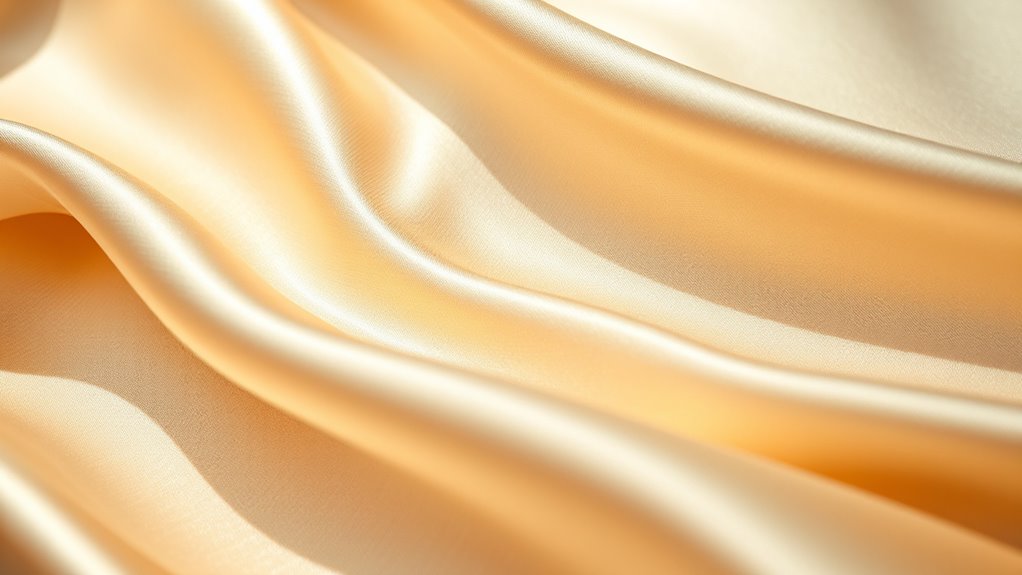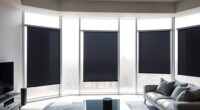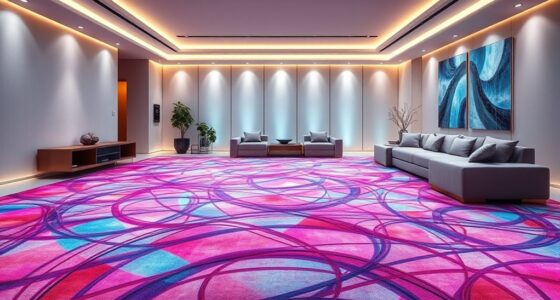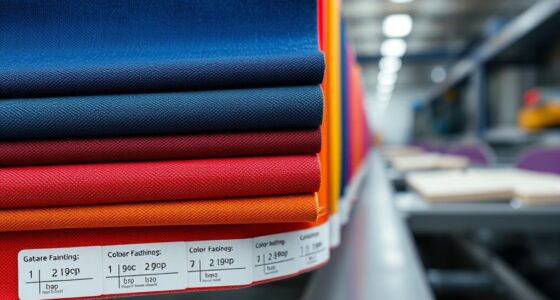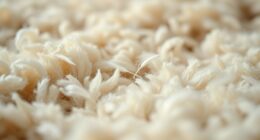Your silk’s pile direction greatly influences how light interacts with its surface. When light hits along the pile, the fibers reflect more shine, making colors appear more vibrant and luminous. Changing the viewing angle or shifting the light causes color shifts, shimmer effects, and dynamic visual changes. By understanding the relationship between pile orientation and light, you can enhance silk’s visual appeal and create stunning effects—learn more about mastering these techniques to elevate your designs.
Key Takeaways
- The silk pile’s direction influences how light reflects, enhancing or dulling the fabric’s perceived color and sheen.
- Light hitting the pile along its natural direction increases shimmer and vibrancy; opposite it, colors appear muted.
- Changing the light angle causes color shifts and dynamic visual effects due to silk’s reflective surface.
- Proper pile alignment under light reveals fiber luster, affecting the perception of depth and richness of color.
- Observing silk under different lighting conditions helps determine pile orientation and its impact on color perception.
Understanding Silk Pile and Its Orientation
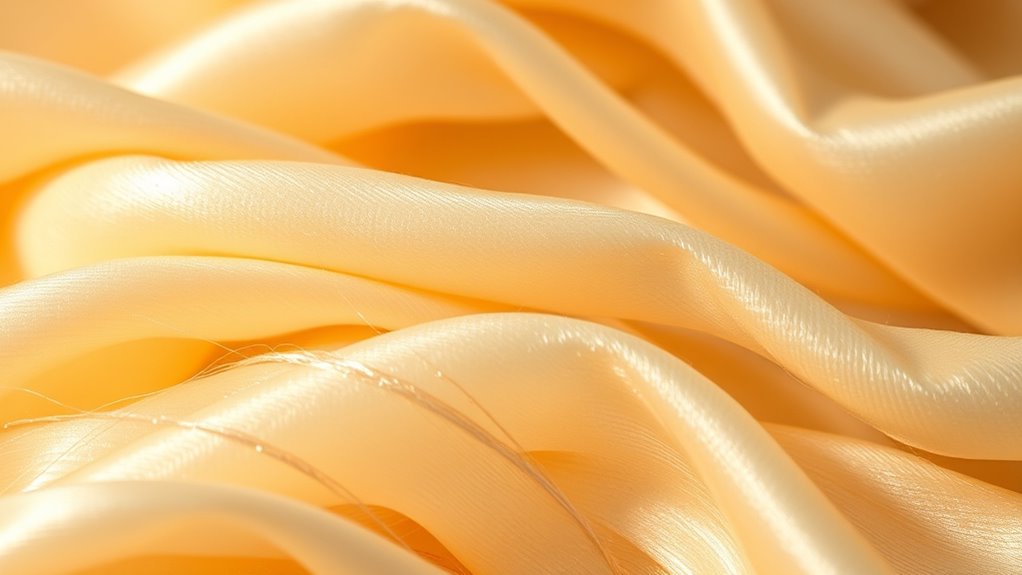
Understanding silk pile and its orientation is essential for achieving the desired look and feel of your silk fabric. Silk’s fiber properties, such as its smooth surface and natural shine, influence how the pile feels and reflects light. The way the pile is cut or brushed creates different fabric textures—whether plush or flat—that impact its visual appeal and tactile quality. When you examine silk with the pile running in a specific direction, you’ll notice subtle differences in color and sheen. Properly understanding and aligning the pile orientation allows you to enhance these effects, giving your silk fabric a consistent, luxurious appearance. Mastering the fiber properties and pile direction helps you achieve the precise aesthetic you want from your silk textiles. Additionally, awareness of light reflection can significantly impact how silk displays its color shifts and sheen, making it a crucial aspect of textile manipulation. Recognizing how fiber orientation influences light interaction enables you to better control the visual effects of your silk fabrics, especially when considering how different headphone types and settings can affect visual perception in multimedia presentations. Understanding the fabric’s nap and its direction can also help prevent color inconsistencies in finished projects, ensuring a polished look. Moreover, knowing how knotting and pile laying techniques are applied can further refine the fabric’s appearance and durability.
The Science Behind Light Reflection on Silk
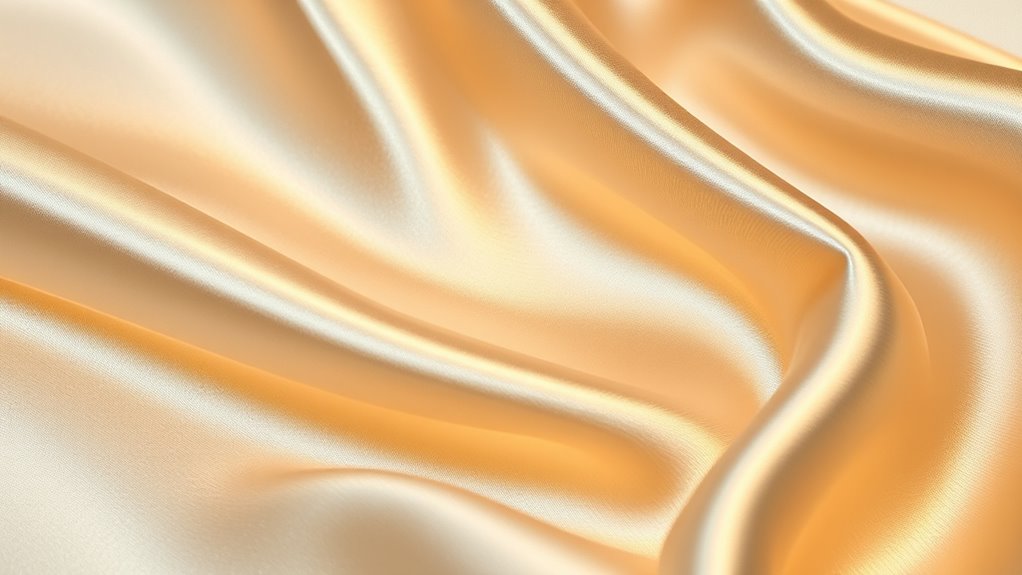
Light interacts uniquely with silk fibers due to their smooth surface and natural luster, creating the fabric’s distinctive shimmer. This effect results from silk’s fiber structure, which influences how light scatters when it hits the surface. Because silk fibers are cylindrical and smooth, they reflect light at specific angles, producing a glossy appearance. Light scattering occurs as photons bounce off the fiber’s surface, with the amount and direction of reflection shaping the perception of color and sheen. When light strikes silk, some is reflected directly, while other wavelengths are absorbed or scattered, affecting how you see the fabric’s color. This interaction is highly dependent on the fiber’s orientation and surface finish, making the light reflection on silk delicate and dynamic. Additionally, the fiber’s surface finish can alter how light interacts with silk, changing its perceived color and sheen depending on how the fibers are treated or woven. The fiber’s surface texture also plays a critical role in determining the intensity and quality of reflected light, further influencing color perception. Moreover, light’s angle plays a crucial role in the way silk’s reflective properties are perceived, emphasizing the importance of viewing conditions on color perception.
How Pile Direction Affects Color Intensity
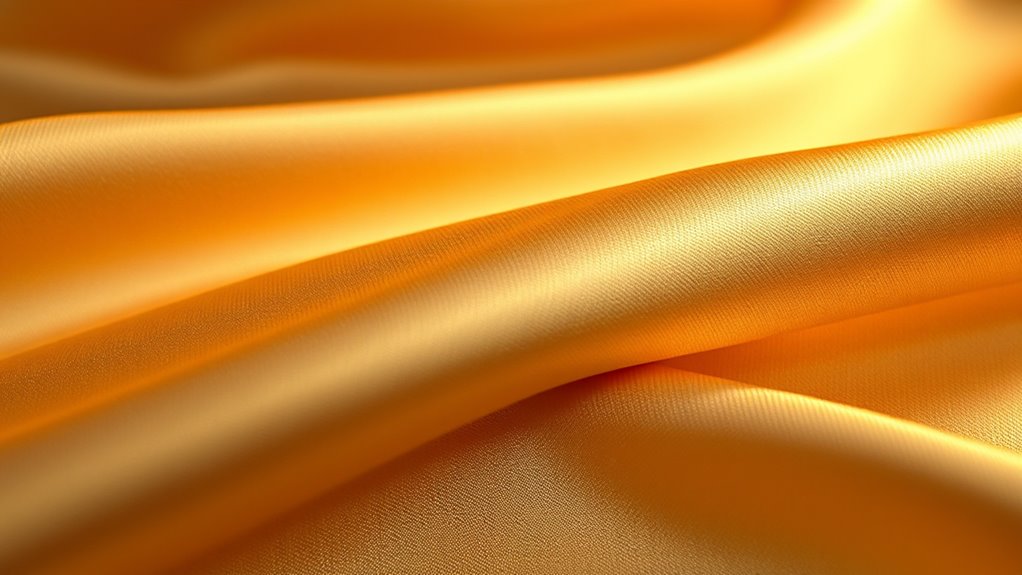
The direction of the pile on silk fabric can markedly influence its perceived color intensity. When you view the fabric along the pile’s natural direction, the fiber sheen enhances the color’s vibrancy, making it appear richer and more saturated. Conversely, viewing against the pile causes the sheen to diminish, reducing color intensity. Pile direction also affects dye absorption; fibers aligned with the light absorb dye differently than those cut against it. This variation impacts how deeply the dye penetrates, altering the overall color richness. Additionally, the fiber structure itself plays a role in how light interacts with the material, further influencing perception. By understanding how fiber sheen and dye absorption interact with pile direction, you can manipulate the fabric’s appearance. Adjusting the pile orientation allows you to enhance or soften color intensity, giving you control over the visual impact of silk textiles. Recognizing light interaction principles helps in predicting and optimizing the visual effects of different pile orientations. Another factor to consider is the material properties, which determine how the fabric responds to light and dye absorption, ultimately affecting color perception. Exploring fiber orientation can also reveal additional ways to manipulate visual effects and achieve desired aesthetic outcomes.
Visual Effects Created by Changing Light Angles
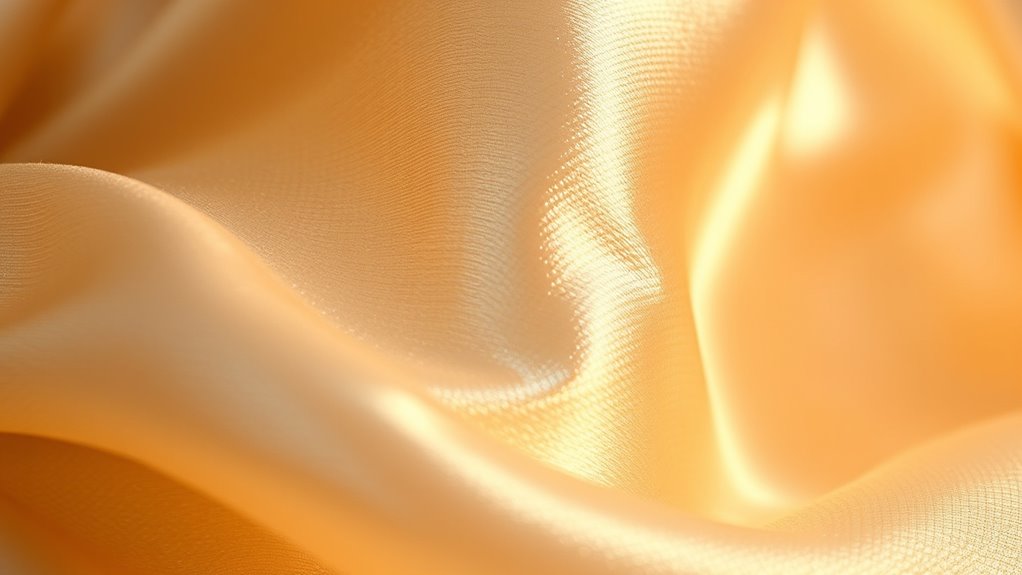
Changing the angle of illumination can dramatically alter the visual appearance of silk fabric. When light hits from different directions, it highlights the fiber texture, revealing subtle variations in the weave and surface sheen. This shifting light also influences how dye absorption appears on the surface, creating dynamic color changes that seem to dance across the fabric. For instance, a slight tilt can make colors appear more vibrant or muted, depending on how the fibers reflect or absorb light. These visual effects emphasize the depth and richness of silk, making the fabric seem to change color with every movement. Understanding fiber properties can help in predicting and enhancing these color variations. By adjusting the light angle, you can enhance or diminish certain hues, revealing the silk’s unique properties and adding a mesmerizing dimension to its appearance. Additionally, awareness of light interaction with different silk finishes can further optimize the visual impact of the fabric. Recognizing how fiber qualities influence light reflection can also assist artisans in choosing the best techniques to highlight silk’s natural beauty. Incorporating knowledge of color dynamics can further refine how silk’s shifting hues are perceived under various lighting conditions, especially when considering the light absorption characteristics of different silk dyes and finishes.
Techniques for Identifying Pile Direction in Silk
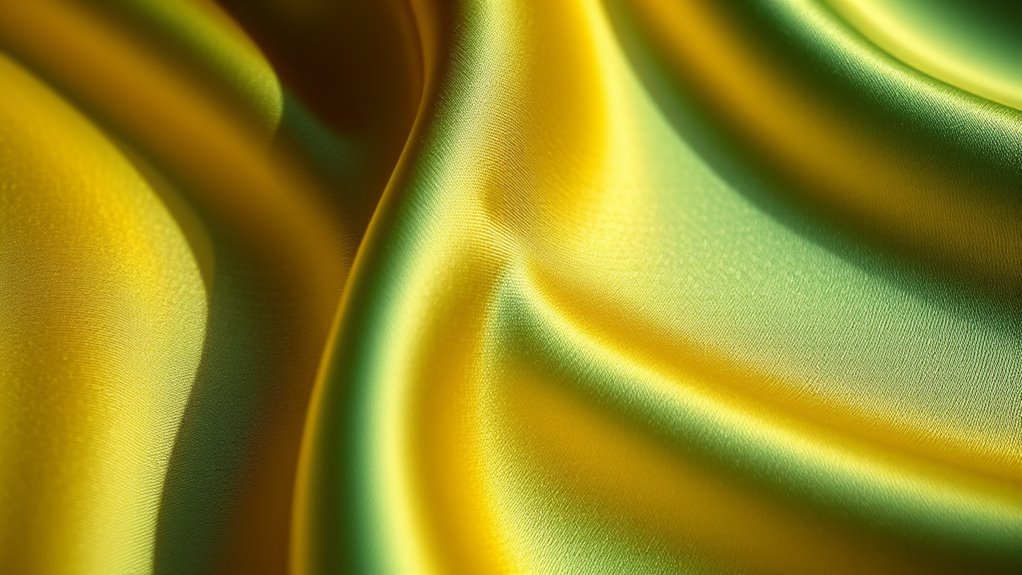
To accurately identify the pile direction in silk, you need to observe subtle visual cues and tactile differences. Look closely at the fiber sheen—notice how the silk reflects light differently depending on the direction of the pile. Pile that’s aligned in one way will appear more lustrous, while the opposite direction may look duller. Feel the texture contrast by gently running your fingers over the fabric. The pile will feel smoother and more uniform when stroked in the correct direction, and slightly rougher or uneven when rubbed against it. These tactile and visual cues help you determine the natural orientation of the silk’s pile, ensuring accurate identification. Mastering these techniques is essential for understanding how light interacts with silk’s surface and for working with the fabric effectively. Additionally, understanding the fiber sheen can help you better interpret the silk’s surface characteristics and improve your ability to identify pile direction accurately.
Practical Tips for Selecting Silk Based on Light Play
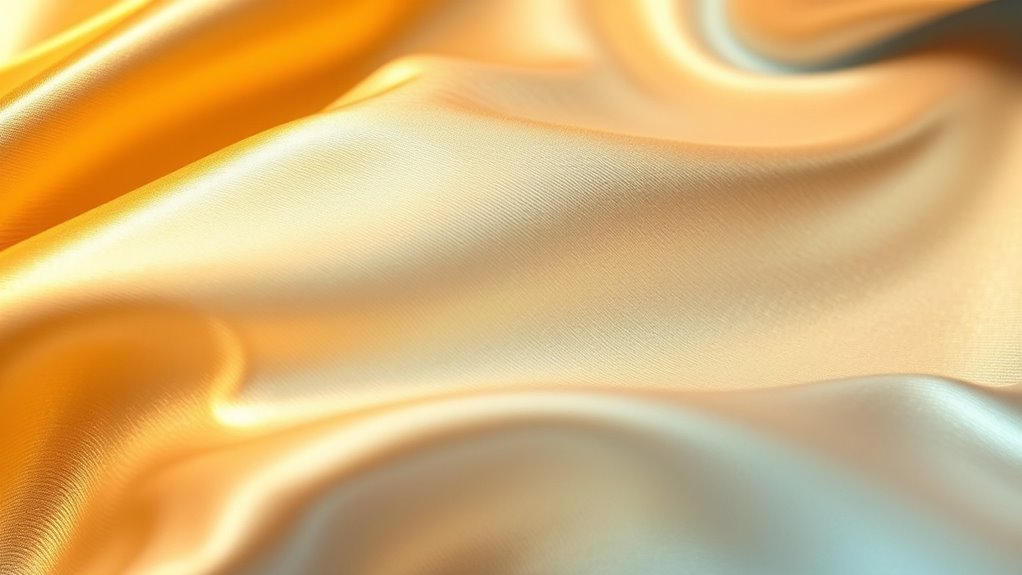
When selecting silk, paying attention to how light interacts with the fabric can greatly enhance your choice. Observe how the fiber shimmer varies as you move it under different lighting conditions; a silk with a strong shimmer can create a stunning visual effect. Look for fabrics that display a noticeable color shift when viewed from various angles—these subtle changes can add depth and richness to your project. Consider the light environment where the silk will be used; natural light often highlights fiber shimmer and color shifts best. If possible, test small samples in different lighting to see how the silk responds. By focusing on these factors, you’ll select silk that captures light beautifully, ensuring your finished piece has dynamic, eye-catching qualities.
Creative Uses of Pile Direction in Textile Design

Understanding how light interacts with silk’s pile direction can reveal a range of creative possibilities in textile design. By manipulating pile direction, you can create embossed textures that add depth and tactile interest, making fabrics stand out. You can also play with color shift effects, where changing light angles produce dynamic visual changes, enthralling viewers. Here are some ways to harness these techniques:
- Use pile direction to emphasize embossed textures, giving your fabric a three-dimensional feel.
- Incorporate color shift by designing with varying pile directions to produce mesmerizing, shifting hues.
- Combine both effects to craft textiles that surprise and engage, perfect for innovative fashion or interior accents.
Exploring these creative uses opens new avenues for expressing artistry through silk’s unique light interactions.
Frequently Asked Questions
How Does Silk Pile Direction Influence Fabric Durability?
Silk pile direction considerably influences fabric durability by affecting fiber alignment and wear patterns. When you align the pile fibers consistently, the fabric resists uneven wear and tear, extending its lifespan. Conversely, if the pile is uneven or misaligned, you may notice faster wear in certain areas. Properly managing pile direction helps maintain the fabric’s strength and appearance, ensuring it stays elegant and durable over time.
Can Pile Direction Affect Silk’s Thermal Insulation Properties?
Did you know that fiber alignment can impact thermal insulation? When you consider silk pile, its pile direction influences how well heat is retained. Pile aligned in one direction traps air more effectively, boosting insulation, while misaligned fibers allow heat to escape. So, by adjusting pile direction, you can optimize silk’s thermal properties, making it warmer or cooler depending on your needs.
Does the Color Shift Vary With Different Silk Fiber Types?
You’ll notice that the color shift in silk varies with fiber dyeing and silk weaving techniques. Different fiber types, like mulberry or tussah silk, absorb dyes uniquely, affecting how colors change under light. When you choose silk for your projects, consider fiber dyeing methods, as they can influence color perception and stability. This variation impacts the visual effect and overall quality, making it essential to select appropriate silk fiber types for desired color effects.
How Do Environmental Factors Impact Pile Orientation Over Time?
Environmental factors like light exposure and humidity effects can influence pile orientation over time. When your silk is exposed to sunlight, UV rays can cause fibers to shift or fade, altering fiber alignment. High humidity can lead to fibers relaxing or swelling, which impacts pile direction. Regularly controlling light exposure and humidity helps maintain the silk’s original pile orientation, preventing unwanted changes and preserving its appearance and color perception.
Are There Cultural or Historical Reasons for Specific Silk Pile Arrangements?
Ever wonder why silk pile arrangements differ across cultures? You’ll find that these patterns often carry deep cultural symbolism, reflecting beliefs, status, or traditions. Historically, craftsmanship played a key role in shaping these designs, showcasing skilled artisans’ unique techniques. These arrangements aren’t just decorative—they tell stories and preserve heritage. So, your exploration reveals a tapestry woven with cultural meaning and historical craftsmanship, making each silk piece a timeless artifact.
Conclusion
Now that you understand how silk pile direction influences light reflection and color perception, you can easily choose and manipulate textiles for stunning visual effects. By paying attention to pile orientation, you’ll unveil new creative possibilities in your designs or décor. Imagine the stunning shifts in color as light hits your silk from different angles—don’t you want to see how this subtle detail can transform your project into something truly extraordinary?
